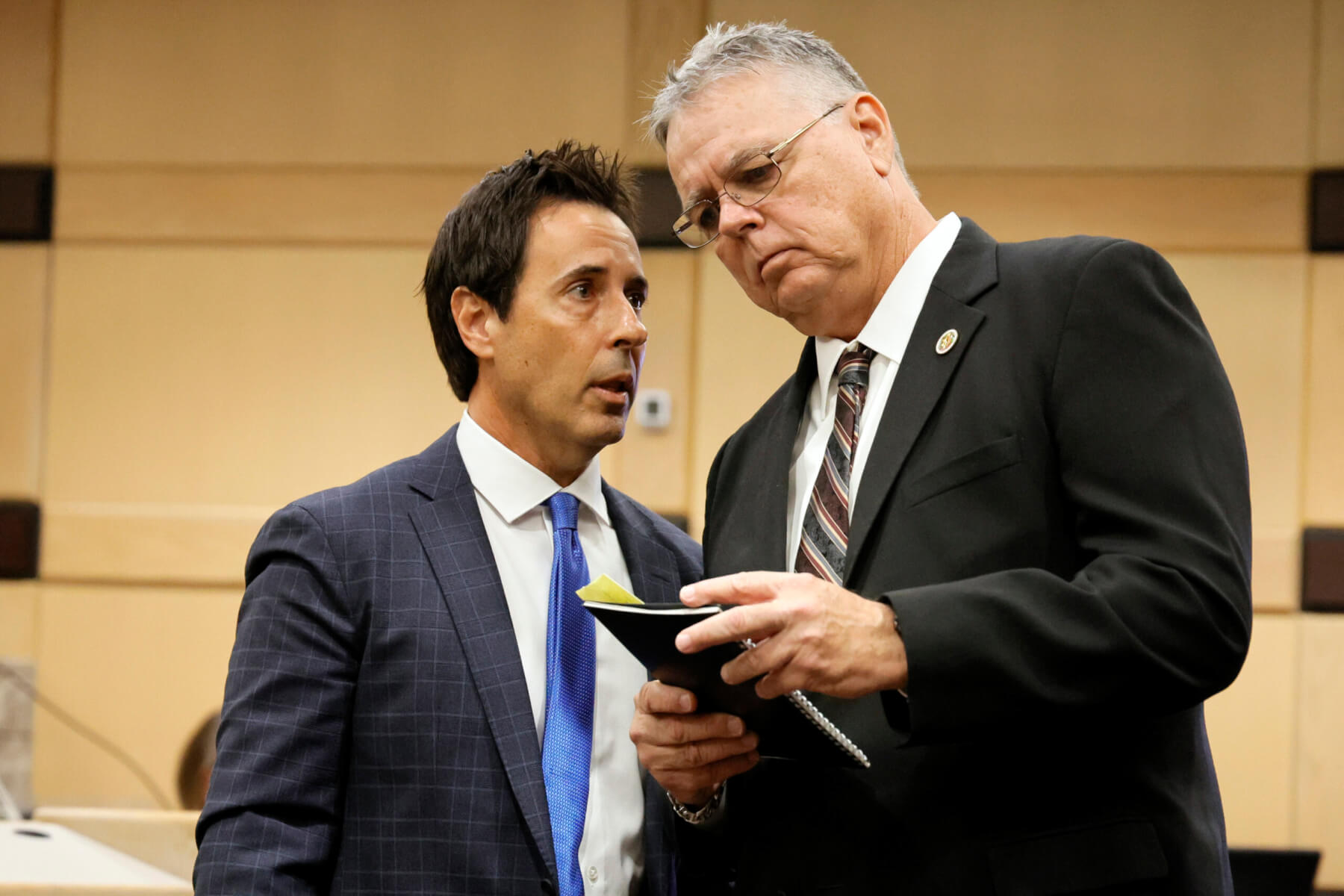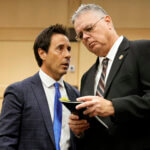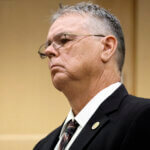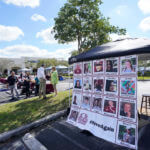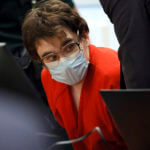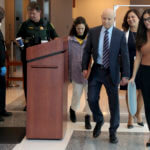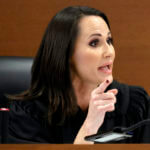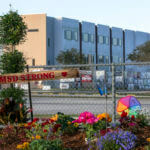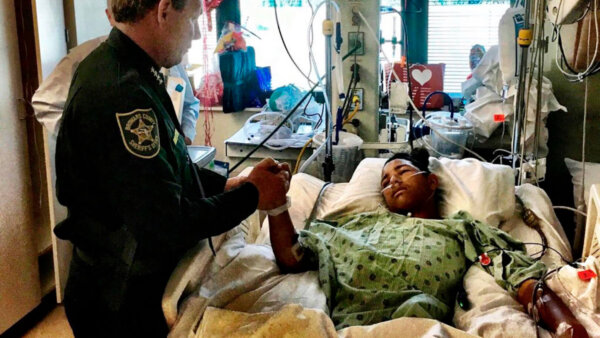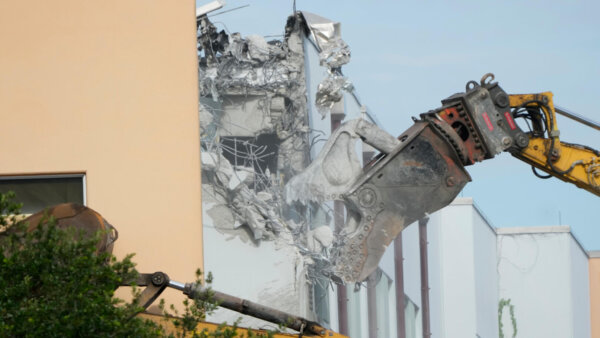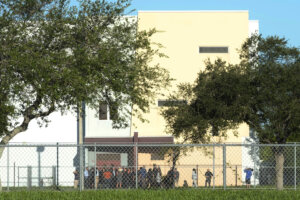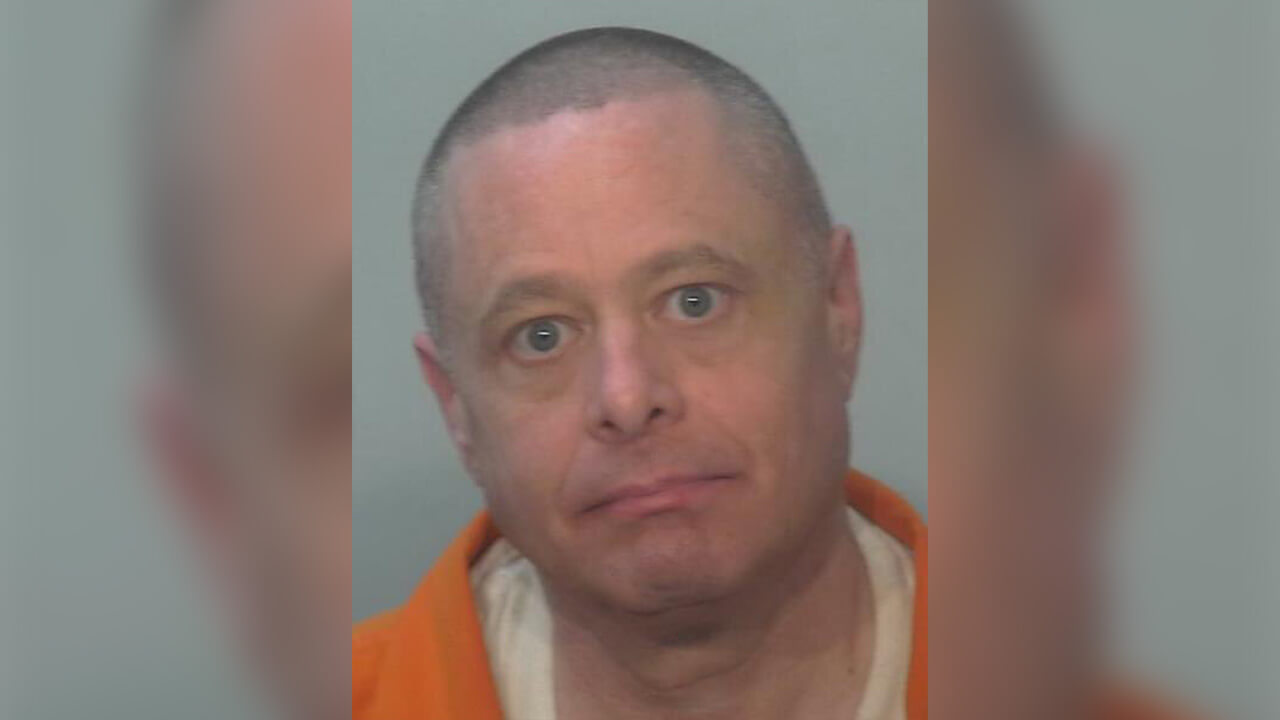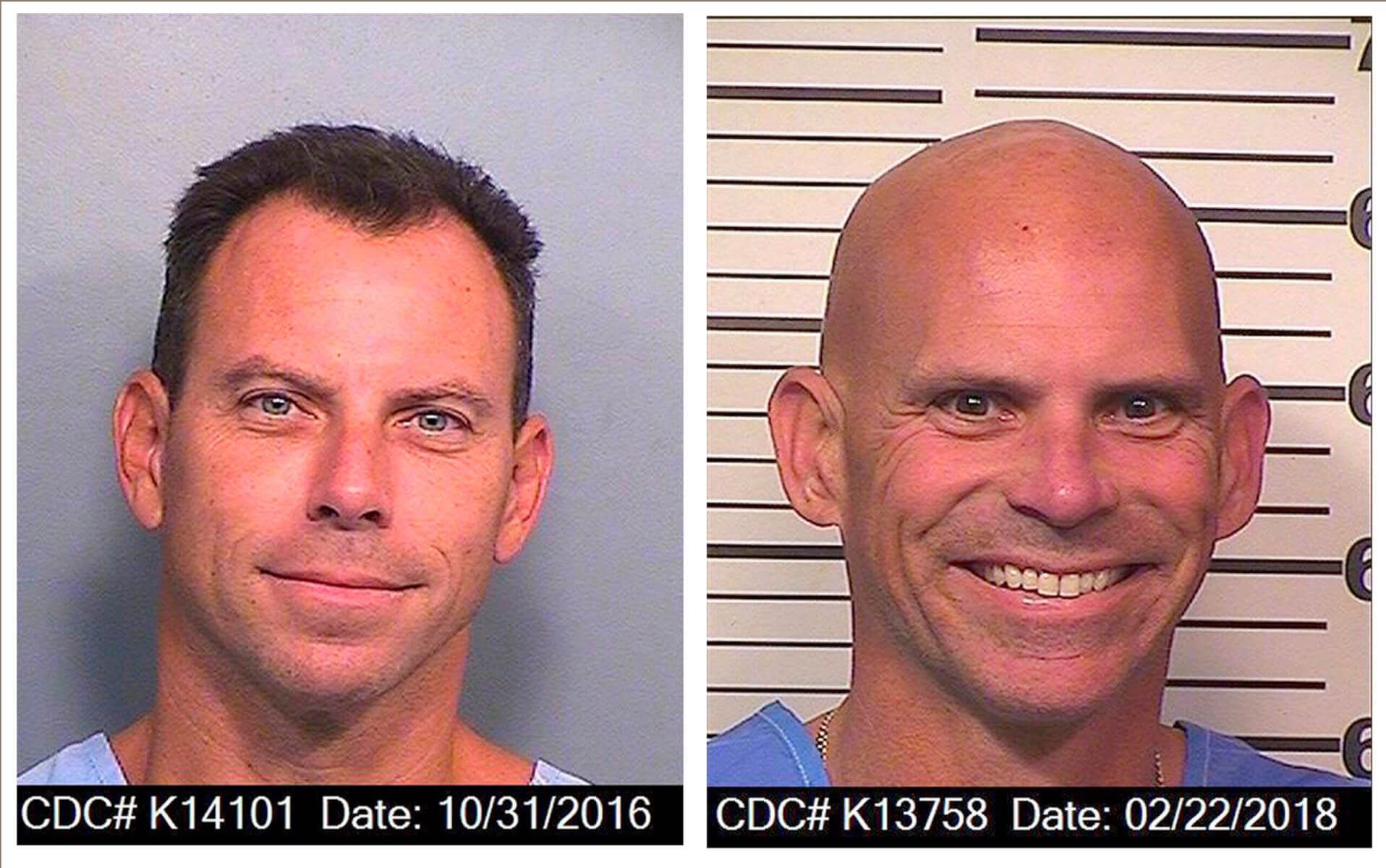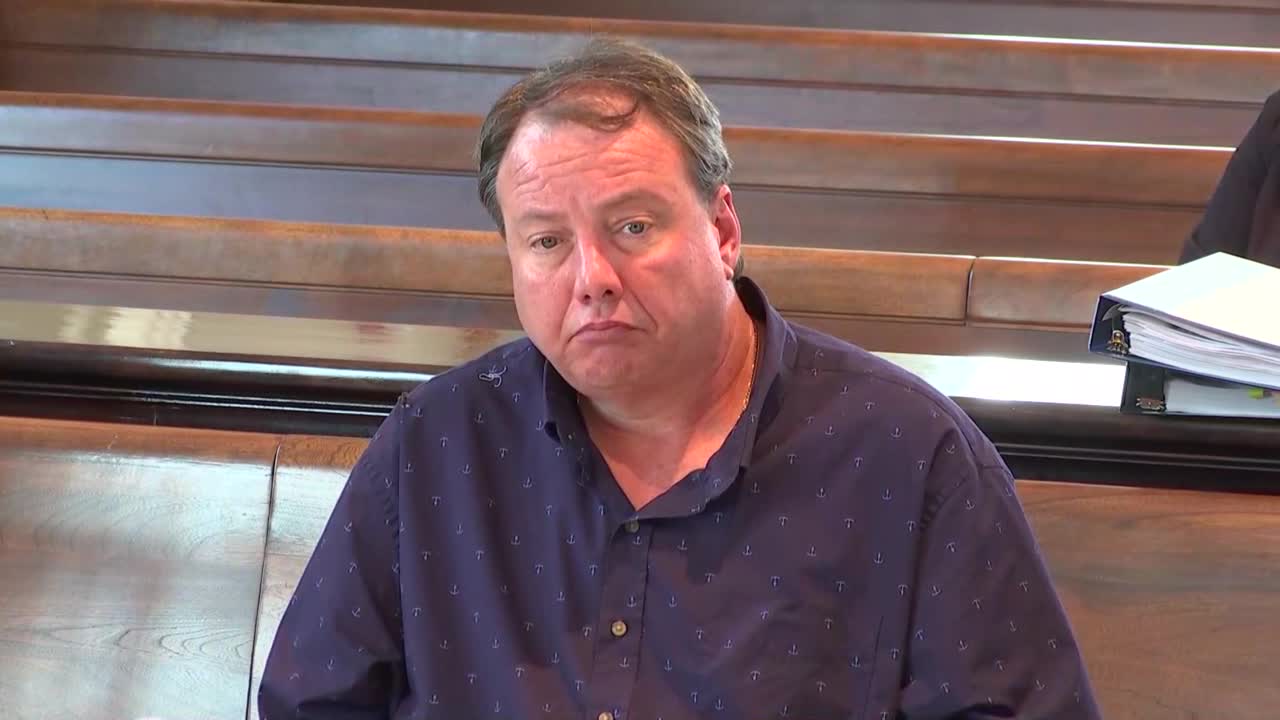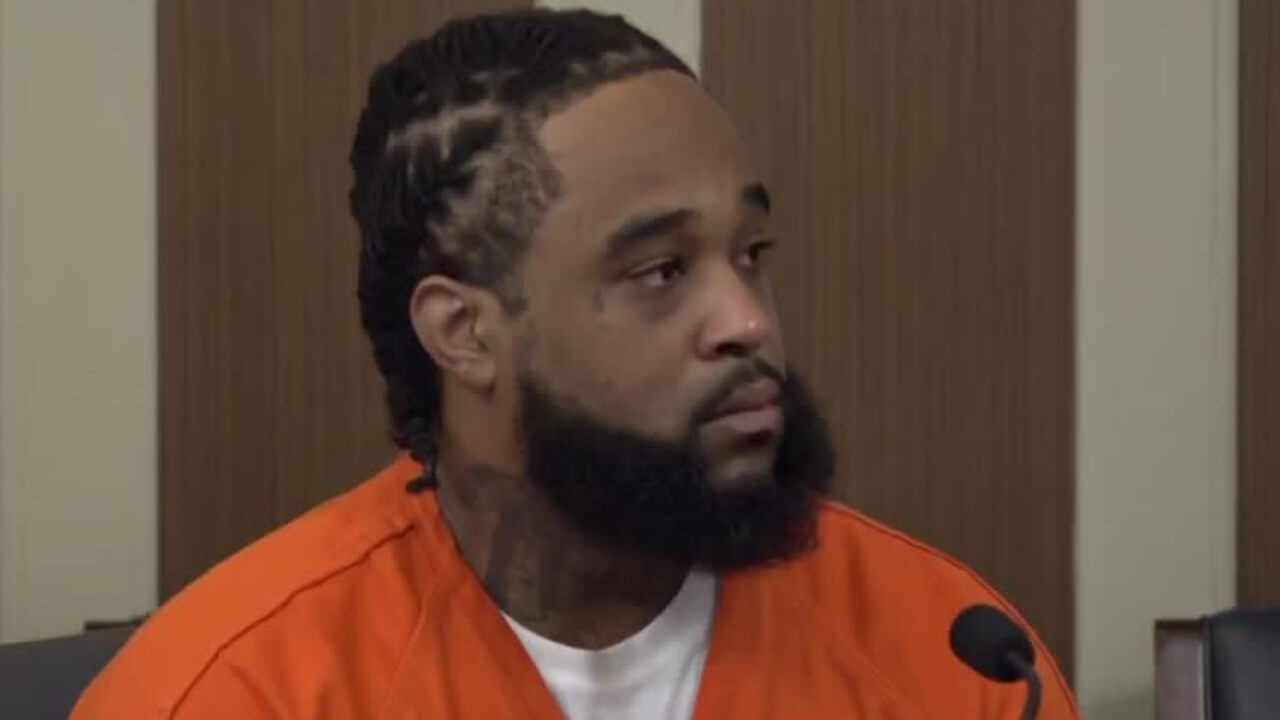FORT LAUDERDALE, Fla. (Court TV) — The armed school resource officer who was on campus the day of the Parkland school massacre and was accused of doing nothing to help prevent the bloodshed has been found not guilty on all counts.
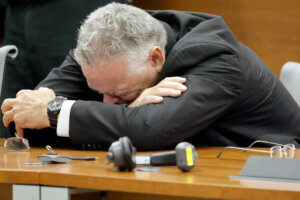
Former Marjory Stoneman Douglas High School School Resource Officer Scot Peterson reacts as he is found not guilty on all charges at the Broward County Courthouse in Fort Lauderdale, Fla., on Thursday, June 29, 2023. Peterson was acquitted of child neglect and other charges for failing to act during the Parkland school massacre, where 14 students and three staff members were murdered. (Amy Beth Bennett/South Florida Sun-Sentinel via AP, Pool)
The Florida jury deliberated for nearly 20 hours over the last four days before reaching a decision regarding the fate of fired Broward County Sheriff’s Office Deputy Scot Peterson.
Peterson was charged with seven counts of child neglect, three counts of culpable negligence, and one count of perjury related to the events of February 14, 2018. On that day, active shooter Nikolas Cruz gunned down 17 people and wounded 17 others with an AR-15-style semiautomatic rifle at Marjory Stoneman Douglas High School.
Peterson did not confront Cruz, and instead could be seen on surveillance video hiding with his gun drawn as the carnage unfolded around him.
READ MORE: Parkland School Shooter Penalty Phase
Following a hearing in May, Peterson told reporters that he was “looking forward” to going to trial, wanted the truth to come out, and insisted he did everything he could on the day 14 students and three school staffers were murdered.
Peterson maintains he opted not to charge into the school building because he thought shots were coming from outside. Prosecutors, however, said Peterson’s actions proved he knew gunfire was occurring within the walls of the school, and that he could have prevented at least some people from getting shot, had he confronted the gunman.
Peterson attorney Mark Eiglarsh assembled defense witnesses who testified that they, too, believed the gunshots were coming from a location other than inside the building.
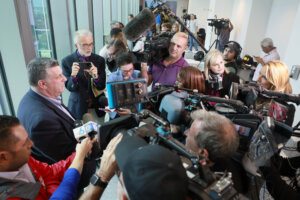
Tony Montalto, father of murder victim Gina Montalto, right, speaks with media after former Marjory Stoneman Douglas High School School Resource Officer Scot Peterson was found not guilty on all charges at the Broward County Courthouse in Fort Lauderdale, Fla., on Thursday, June 29, 2023. Peterson was acquitted of child neglect and other charges for failing to act during the Parkland school massacre, where 14 students and three staff members were murdered. (Mike Stocker/South Florida Sun-Sentinel via AP, Pool)
The child neglect and culpable negligence charges against Peterson were related to the 10 people who were shot — six of which were fatalities — on the school’s third floor after Peterson arrived at the building. He was not charged in connection with the casualties that occurred on the first floor. Prior to Peterson’s arrival, Cruz killed 11 people and injured 13 people on the first floor.
RELATED: A Court TV producer’s firsthand look inside the scene of Parkland school shooting
In October 2021, Cruz pleaded guilty to murdering 17 people and wounding 17 others in the Valentine’s Day 2018 tragedy that remains one of the deadliest school shootings in U.S. history. The jury recommended that he spend life in prison without the possibility of parole, sparing him death. He was ultimately handed 34 consecutive life sentences.
Peterson, now 60, was given the moniker “the coward of Broward” by some Parkland victims’ parents. He retired not long after the massacre, but was retroactively fired and charged the following year.
Peterson, who was free on bail and currently resides in North Carolina, had faced the possibility of over 96 years in prison, had he been convicted.
TRIAL HIGHLIGHTS
DAY 14 – 6/29/23
- The 6-person jury reached its verdict against Peterson after 19 hours of deliberation over four days: not guilty of 11 charges, including 7 counts of child neglect, 3 counts of culpable negligence, and one count of perjury.
- WATCH: Verdict – FL v. Scot Peterson: Parkland School Cop Trial
- Raw emotions erupted in the courtroom as Judge Martin Fein announced the verdicts.
- Peterson and his attorney Mark Eiglarsh sobbed and melted into the table in front of them. Peterson’s wife, Lydia Rodriguez, and her relatives sobbed and embraced in the gallery alongside Eiglarsh’s family.
- It appeared that no one related to the victims in the case — those who were killed or injured on the third floor — was in the courtroom for the verdict.
- The parents of first-floor victims Gina Montalto and Luke Hoyer were in the courtroom for the verdict. Tony Montalto slowly shook his head in disgust as the verdict as Montalto’s wife and the mother of Luke Hoyer left the courtroom.
- Jurors declined to comment as they left the courthouse escorted by deputies. Their verdict appeared to validate the defense’s claim that Peterson did everything he could that day with the limited information he had and couldn’t tell where the gunshots were coming from in time to stop them.
- Broward County prosecutors declined to speak after the verdict. Instead, they issued a statement standing by what they described as their attempt to hold a school resource officer responsible “for not doing his job.”
- “As parents, we have an expectation that armed school resource officers – who are under contract to be caregivers to our children – will do their jobs when we entrust our children to them and the schools they guard,” the statement said. “Let us remember that unarmed civilians ran into that building that day and lost their lives trying to save and protect the children and educators who were massacred and injured.”
- Speaking to reporters after the verdict, Tony Montalto stood by his position that Peterson’s inaction “contributed” to the massacre and to the lingering pain in the community. Montalto said he struggled to understand how the jury reached its verdict after seeing security video of Peterson standing in an alcove in a building facing the shooting site during the four minutes it took the shooter to carry out his rampage on the third floor.
- WATCH: Parkland School Cop Trial: Victim’s Dad Reacts to Verdict
- Montalto said the system had yet again failed the victims and their families. He derided the “good sportsmanship” of the cheering defense team in the background.
- Speaking publicly for the first time since this trial began, Tom Hoyer – father of first-floor victim Luke Hoyer — said it was obvious that Peterson knew the gunfire was coming the 1200 building because that’s where he was dropped off by the campus monitor who saw the gunman enter the building. “He could’ve been a hero” had he taken a few steps forward to enter the 1200 building and investigate, Hoyer said. Instead, Peterson was a coward and took cover in an alcove of the 700 building for 40 minutes, Hoyer said.
- Hoyer’s wife, Gena, released a statement echoing her husband’s sentiment. “I don’t think a jury in Broward County is EVER going to hold anyone accountable for the multiple failures at MSD,” she said. “I know Mr. Peterson believes his own narrative to sleep at night. The truth is he was NEVER going into the 1200 building.”
- “I got my life back,” Peterson told reporters after the verdict. He said the only person to blame for the mass shooting was “that monster,” referring to gunman Nikolas Cruz. Peterson said that all first responders on that day did “the best we could with the information we had, and God knows we wish we had more.”
- WATCH: Scot Peterson Speaks After Verdict: I Got My Life Back
- Peterson said he and his wife have mourned the victims for the past four years. He said he wished he could hug the families and tell them he’s sorry and offered to speak with them anytime.
- Montalto flatly declined the offer, saying it wouldn’t bring back his daughter or any of the victims.
- Peterson’s attorney hailed the verdict as a sign that “the system works.” He praised the jury for rejecting what he described as the “false narrative” that former sheriff Scott Israel ignited a press conference two days after the shooting accusing Peterson of failing to act to “kill the killer.”
- WATCH: Scot Peterson’s Lawyer Speaks Out After Acquittal
- Several civil actions are pending against Peterson from the victims’ families. When asked if he planned to sue Scott Israel or anyone else involved in his prosecution, Peterson said “everything’s on the table.”
- READ MORE: Deputy acquitted of failing to act during Parkland school shooting
DAY 13 – 6/28/23
- The 6-person jury has deliberated for 14:40 over three days.
- No questions from the jury Wednesday.
- Their last request on Tuesday was for the school surveillance, which amounts to six hours total.
- Families of the victims and the defendant stayed closed to the courtroom throughout the day.
- At the end of the day, prosecutor Steve Klinger asked the judge to remind everyone to make sure they’re mindful of the jurors when they’re around, saying that no one has done anything wrong, but they’d received word that the defendant and his family were near some jurors in the parking lot.
DAY 12 – 6/27/23
- Judge Martin Fein sent the 6-person jury home for the day at 5 p.m. after they’d deliberated for nearly 6 hours and 30 minutes, bringing their total deliberation time to about 9 hours.
- The jury sent two notes:
- Note 1: Request for posters and visual aids that both sides used during the trial. DENIED because they were not admitted into evidence.
- Note 2: Request for a hard drive password to view security camera footage of the school campus. GRANTED.
- WATCH: Parkland School Cop Trial: Jury Deliberates for a Second Day
DAY 11 – 6/26/23
- Judge Martin Fein dismissed the jury for the day at 6 p.m. after 90 minutes of deliberations.
- The jury began deliberating after hearing four hours of closing arguments and an hour of jury instructions.
- Peterson shook his head in disgust at various points during the prosecution’s closing arguments.
- Assistant State Attorney Kristen Gomes delivered the first closing for the prosecution:
- By choosing to “run away” from the 1200 building, Scot Peterson left a “predator unchecked” and an “unrestricted killer” wandering the third floor for four minutes when Peterson should have intervened.
- His job didn’t require him to go on a “suicide mission,” but it did call for him disrupt the shooter with his “mere presence” and force a different outcome.
- Instead, he prioritized his life over those of the victims by staying outside for 40 minutes, violating his duty as their caregiver.
- WATCH: Parkland School Cop Trial: Prosecution Closing Argument
- Defense lawyer Mark Eiglarsh ran out of time delivering his closing argument:
- The state’s case hinges on an “erroneous belief” that Peterson knew kids were being shot inside the 1200 building, but neither he or witnesses who testified could say for sure where the gunfire was coming from.
- The evidence shows that multiple people failed to share with Peterson critical real time intelligence that would have sent him into the building.
- Peterson is a hero who risked his life doing everything he could to protect people, from announcing “shots fired” and ordering a code red to making himself “vulnerable” by holding his position without donning a bulletproof vest. Instead of thanking him… we’re prosecuting him.
- WATCH: Parkland School Cop Trial: Defense Closing Argument
- Assistant State Attorney Chris Killoran invoked the Nike catchphrase “Just do it” to describe all the things Peterson should have done: If you can’t hear, you move. If you can’t see, you move… you don’t just stand there.
- A juror who is a victim advocate in the Broward State Attorney’s office was excused after it came out that she attended the Parkland school shooter’s penalty phase and was more involved in the case than she previously disclosed.
- READ MORE: Prosecutor: Cop fled during massacre, put own life ahead of students’
DAY 10 – 6/23/23
- The defense rested its case after calling 20 witnesses.
- Parkland resource officer took the stand and testified he did not know where the shots were coming from, and that communication between the departments was insufficient.
- On cross, prosecutors implied the officer was testifying to protect his friend.
- A former student testified, saying they could not tell where shots were coming from.
- A communications officer testified to the breakdown in communication, saying that deputies had trouble communicating and that communication was never patched.
- Once dispatchers heard shots fired, backup was sent immediately.
- WATCH: Scot Peterson Will Not Testify in Parkland School Cop Trial
DAY 9 – 6/22/23
- Jurors heard from three students and two teachers at Marjory Stoneman Douglas High School who were in the 700 building the day of the shootings.
- Two sisters in the same theater class had differing descriptions on where they thought the gunshots came from. One thought they came from the senior parking lot, the other thought they came from the football field. Neither sister saw Scot Peterson.
- MORE: Witnesses describe confusion in locating source of gunfire in Parkland
- Dylan Redshaw became emotional while testifying via Zoom. She described hearing bangs outside the building after she hid.
- WATCH: Parkland School Cop Trial: Teacher Testifies for Defense
- Broward County Sheriff’s Office Deputy Brian Goolsby testified that he had to go outside to talk on his radio, because it didn’t work well inside of the building.
- Goolsby said he heard Peterson’s transmission on the radio of where the shooter was, and described how the news of the shooting overwhelmed him phsyically.
- Goolsby described tunnel vision, increasing heart rate, a rush of adrenaline, shaking hands and dry mouth.
- Broward County Director of Regional Communications Angela Mize testified that the Coral Springs Police Department had their own computers, phones and radios because they wanted to be autonomous.
- All 911 calls made by children from inside the school went to Coral Gables, while calls from landlines would have gone to the Broward County Sheriff’s Office.
- Coral Gables dispatchers contacted sheriff’s dispatchers 2-3 times telling them there was an incident at the school, but the dispatchers never spoke with the callers.
DAY 8 – 6/21/23
- Judge Martin Fein narrowly denied the defense’s motion for a judgment of acquittal on all counts after expressing doubt about the strength of the evidence showing that Scot Peterson caused the vicitms’ injuries — an element of the charge of child neglect.
- The defense’s case began in earnest with testimony from MSD students and staff who, like Peterson, said that they initially mistook the gunshots for fireworks and could not tell where the loud pops were coming from.
- Peterson’s supervisor, BSO Sgt. Ryan Miller, said he thought he heard the gunshots coming from the football field, a belief that was affirmed by BSO Dep. Michael Kratz’s (erroneous) radio call that the shots were fired by the football field.
- Miller said that Peterson was “distraught” when Miller saw him the next day and thanked him for his efforts.
- Det. John Curcio — the lead detective on the shooting investigation — teared up while describing the goal in an active shooting: “stop [the shooter] from killing people… slowing him down… anything to help kids find safety.”
- Curcio testified about statements Peterson made to him in an interview that led to Peterson being charged with perjury:
- He only heard 2-3 shots, while surveillance video shows Peterson outside the 1200 building for more than four minutes while approximately 70 rounds were fired on the second and third floors.
- He didn’t see anyone leaving the 1200 building before police went in to lead the students out. Multiple witnesses have testified to seeing Peterson outside the building but the timing is not clear.
DAY 7 – 6/20/23
- The jury heard from more witnesses who described Peterson standing in place, flustered, while others rushed inside the building or to other parts of the campus to assist students and staff. On cross, the witnesses agreed that they didn’t know what was going through Peterson’s mind or what real-time intelligence he had about the shooter’s location or the source of the gunfire, which could hinder his ability to respond effectively.
- Sunrise Police Lt. Craig Cardinale Described rushing to the school to search for his son and being surprised to find the school resource officer pacing and mumbling to himself outside the 1200 building. Cardinale said to Peterson, “what the (expletive) are you doing out here, we need you in there.” Cardinale acknowledged the stress of the situation but but insisted it was a “bad day for everyone” and “this was a time for action.”
- Former MSD security monitor Kelvin Greenleaf said he heard gunshots inside the 1200 building upon pulling up in a golf cart with Peterson while Peterson’s face went “blank” and appeared to struggle to comprehend what was happening. Greenleaf narrated video of his and Peterson’s movements and used maps to point out their locations.
- Retired campus monitor Elliot Bonner said he radioed in a code red — not Peterson — after hearing what he was certain were gunshots from the 1200 building. On cross, Bonner agreed that he didn’t give a location for the shots on the radio because he didn’t know where they were. He acknowledged a strong echo effect on the campus that made it difficult to detect the source of noises or activity on a regular day.
- Three more forensic pathologists described the devastating gunshot injuries to victims Peter Wang, Scott Beigel and Cara Loughran.
DAY 6 – 6/15/23
- Lt. Col. Samuel Samaroo – a former Broward Sheriff training supervisor who oversaw, approved and taught some of the active shooter and firearms training courses that Peterson completed over his decades-long career – said Peterson’s actions on the day of the shooting were inconsistent with his training and responsibilities.
- Samaroo said that Peterson had a duty to enter the 1200 building to investigate, even if he wasn’t certain where the gunfire was coming from, so that he could confirm its source and achieve the main goal of minimizing loss of life using a “priority of life” scale that privileges victims, then law enforcement, then the shooter.
- READ MORE: Supervisor: Deputy didn’t follow training during Parkland school massacre
- On cross, the defense pointed out that BSO’s active shooter policy at the time gave a deputy acting alone the choice to enter a building alone based on the strength of the rea-time information at his disposal. Samaroo reluctantly agreed that several factors – including BSO’s “colossal failure” of a radio system, the lack of real-time information-sharing between Coral Springs Police and BSO, and the “tunnel vision”-inducing stress of the situation – could have hindered Peterson’s ability to collect and assess real-time information.
- Two more defense witnesses testified out of order.
- BSO Dep. Michael Katz further illustrated how BSO’s impaired radio systems and information gaps affected his response. After getting static from dispatch over BSO radio, Katz said he first learned of “possible” shots fired from Peterson over the radio. Katz was the person who announced “shots fired by the football field” over BSO radio after hearing 4-5 shots from his position between Holberg Road and the edge of the school football field, though it would later turn out that the shots came from the 1200 building. Katz also radioed “possible shooter and victims in the 3-story building” after learning the information from Coral Springs officers. On cross, Katz said he would have kept moving towards the 1200 building if Peterson had not told him to stay away and keep others back.
- MORE: Parkland School Cop Trial: Radio Transmissions Played in Court
- Retired BSO Lt. Michael DeVita, who nominated Peterson for deputy of the year in 2016 as his supervisor, spoke to how BSO’s radio system “failed” them, how the cameras they were relying on for real-time information were 25 minutes behind, and described his experience with tunnel vision that day.
DAY 5 – 6/13/23
- Testifying out of order during the state’s case, Marjory Stoneman Douglas campus monitor Ana Ramos testified that Peterson ordered the “code red” over the school’s radio, directing everyone to seek cover in classrooms, contrary to prosecutors’ claims and witness testimony that someone else enacted the protocol.
- Ramos said that Peterson projected shock, urgency and concern when he got on the radio and said, “go back.” Ramos said he also directed assistant principal Jeff Morford to the camera room to scan surveillance footage for the shooter.
- WATCH: Parkland School Cop Trial: Day 5
- On cross, Ramos made it sound like Peterson told Morford to look in the 1200 building, suggesting Peterson knew where the shooter was but failed to confront him.
- Prosecutor Christopher Killoran tried to contrast Peterson’s actions with those of Ramos, who said she rushed into the hallway to usher students to safety, whereas Peterson never entered the 1200 building.
- Coral Springs Capt. Edmond DeRosa testified to Peterson’s apparent knowledge that the shooter was in the 1200 building, saying that Peterson pointed him towards the building when DeRosa asked where the shooter was.
- DeRosa described his efforts to locate the shooter, including detaining another student, entering the 1200 building and scanning the area on foot after learning the shooter had fled the building.
- Crime scene detectives identified photos showing the vast number of bullets and shell casings collected from the walls and hallways of the building.
- The assistant medical examiners who performed autopsies on Meadow Polack and Jaime Guttenberg described their devastating gunshot injuries and opined that they died within minutes of being shot.
DAY 4 – 6/12/23
- The jury heard more heroic anecdotes from responding officers who rushed to the scene, prepared to put themselves in the line of fire, when they charged into the 1200 building to search for the shooter and rescue/treat students.
- Officers who testified said their training taught them to run toward gunfire, even if you can’t tell where it’s coming from.
- Det. Brett Schroy, whose son was a student on campus that day, testified about responding on-duty that day.
- He said he couldn’t remember what time he arrived. Schroy said he was focused on whether he would try to find his son or the shooter, not time.
- Testified that the “best course of action” was to save his son by saving everyone else (by finding the shooter).
- English teacher Stacey Lippel teared up recalling the moment she saw Scott Biegel’s body and realized, “this was really bad.”
- Lippel said that when she first heard popping she assumed it was firecrackers or balloons.
- Other students around her asked her what did she think the noise was, because they didn’t think it was gunfire either. Lippel described the sound as being like a computer cart pushed on concrete.
- WATCH: Parkland School Cop Trial: Day 4
DAY 3 – 6/9/23
- Students who survived the shooting at Marjory Stoneman Douglas High School testified about the scene inside the building during the shooting.
- Marian Kabachenko, who testified with the assistance of a translator, is from Crimea and had been in the United States for about six weeks at the time of the shooting. He said he was in geography class with headphones on working on a project when the fire alarm went off.
- Kabachenko suffered an injury to the back of his upper leg.
- Kabachenko testified that he knew there was one shooter but he heard shots once he got outside of the building and was scared he was being targeted, prompting him to run again.
- Arman Borghei was on the 3rd floor of the 1200 building with the 2nd fire alarm went off.
- Borghei testified that he looked out of the window and saw Scot Peterson standing outside the building with his gun drawn. He said that Peterson was looking to the west (towards the football field.)
- Ashley Paseltiner was on the first floor of building 7, in a classroom that faced building 12. She testified that she initially thought the roof was collapsing.
- Paseltiner testified that she could hear gunshots, but did not see Scot Peterson that day.
- Former Coral Springs Police Officer Richard Best testified that when he responded to the scene he saw Peterson and went to him, believing his knowledge about the campus would be helpful.
- He asked Peterson what the situation was, and as told that shots were fired on the second or third floor, and it was clear to him that Peterson meant inside the 1200 building.
- Best said that Peterson did not go with him when he went toward the 1200 building and that if he had been told to stay back he would have continued going into the building anyway.
- Former Broward County Sheriff’s Sgt. Richard Van Der Eems, who helped clear the third floor with the SWAT team, testified that there was a lot of chaos: screaming, crying and broken glass.
- Testified that training from the Broward County Sheriff’s Office is to go in and stop the threat.
- Testified that he never saw Peterson enter any buildings.
- Acknowledged there were radio issues, and that when he would try to talk he would only hear a tone.
- Coral Springs Police Officer Tim Burton testified that Peterson was in a “low ready” position at the scene and that he was concerned the shooter might be in the parking lot to the east based on what Peterson told him.
- The defense called its first witness, Melody Herzfeld, out of order because of availability issues.
- Herzfeld was a theater teacher in the 700 building and testified that she thought she heard firecrackers from the direction of the football field.
- Herzfeld said she saw Peterson speaking on the radio but did not know whether it was the sheriff’s office or school radio.
DAY 2 – 6/8/23
- WATCH: Shooting Survivor Says He Yelled for Help, But None Came
- WATCH: Parkland Shooting Survivor Watches Surveillance Video
- WATCH: Parkland School Cop Trial: Gunshots Played in Court
- READ MORE: Parkland shooting survivors testify in trial of school resource officer
DAY 1 – 6/7/23
- The state and the defense delivered opening arguments.
- Danielle Gilbert, who was in the 11th grade on Feb. 14, 2018, described the day of the shooting.
- She said she ran to the windows, but the teacher then told them to get in the corner.
- Gilbert described the shots as very loud.
- A recording Gilbert made while she was in the school was played for the jury.
- Gilbert described the 20 minutes between the end of the shootings and when the SWAT team rescued them as the longest 20 minutes of her life.
- Former teacher Ivy Schamis testified about what she experienced the day of the shooting.
- Was inside classroom 1213 when the shooting began; Nicholas Sworet and Helana Ramsey were killed.
- WATCH: Parkland School Cop Trial: Former Teacher Testifies
- An officer with the Coral Springs Police Department, Jeffrey Heinrich, who was off-duty and helping at Marjory Stoneman Douglas, because his wife was an employee and his son attended the school, described hearing the first shots fired.
- Heinrich was wearing athletic shorts and a t-shirt and was unarmed
- Heinrich couldn’t say where the shots were coming from.
- He provided medical assistance to Kyle Laman, who had fled the third floor and was shot in the foot. Kyle gave a description of the shooter, and said that the gunman had an AK-47 weapon.
- READ MORE: Wide disagreement reigns in trial of deputy accused of not stopping Parkland killer








